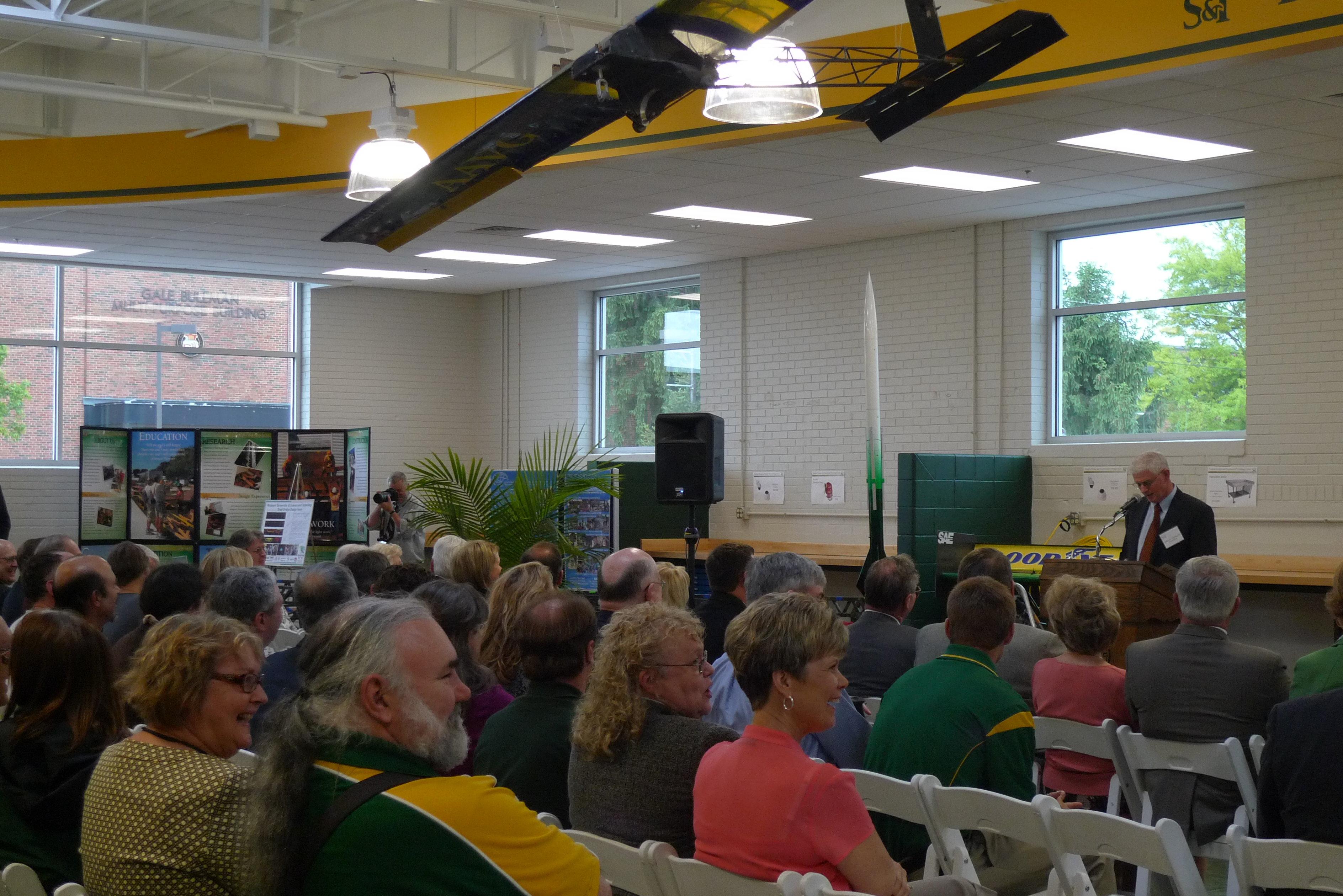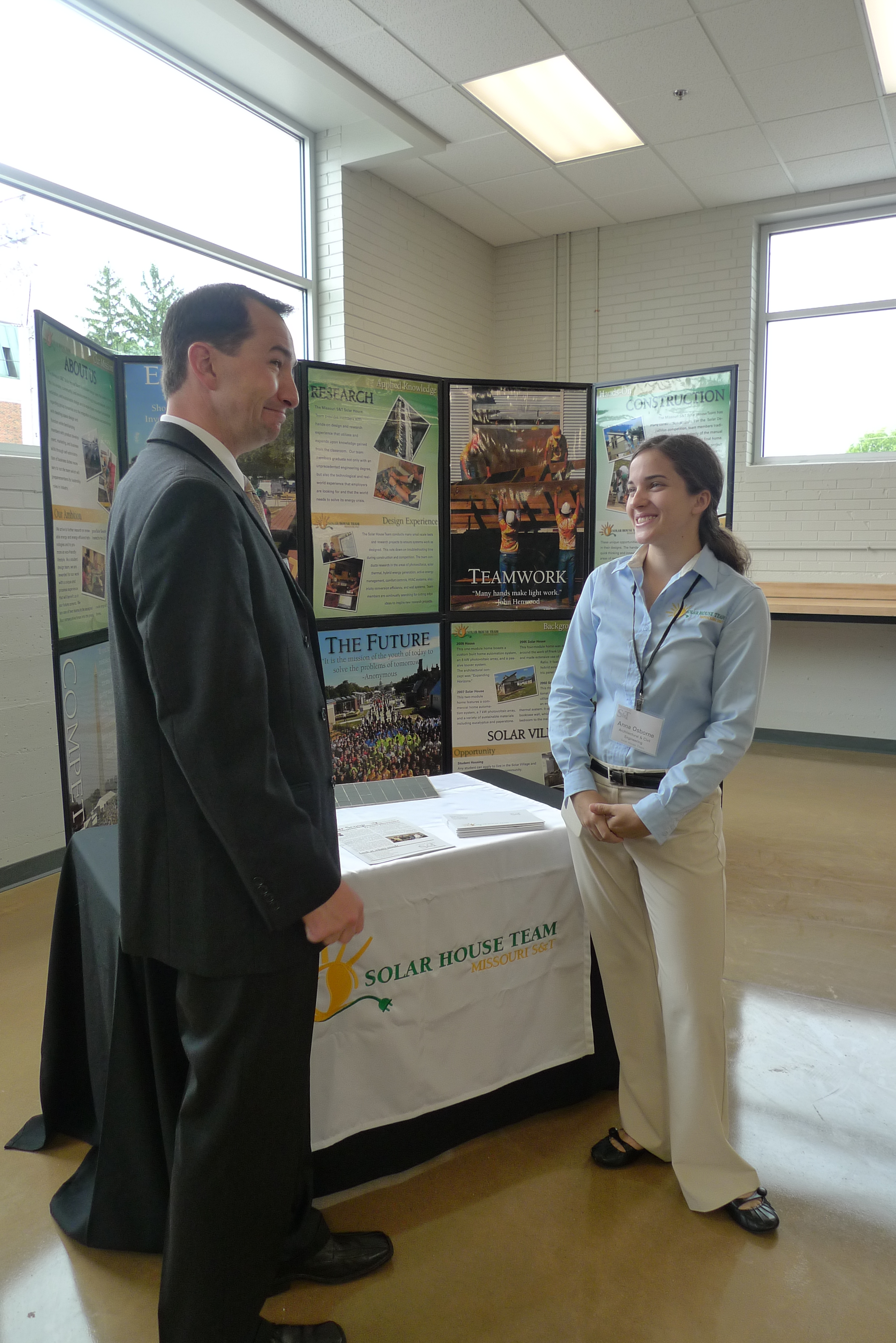SPACE Architecture Tour
Kummer Student Design Center Dedication
Earth Day Celebration
April 22, 2011 marked the 10th Annual Rolla Earth Day Celebration. Despite the looming threat of rain, the sun persevered! Over 400 local elementary school kids excitedly toured the Solar Village, guided by students from the Missouri S&T Solar House Team. Many curious questions were answered including, “How do solar panels work?”. One team member answered, “It’s like a peanut butter and jelly sandwich sitting in the sun. When the sun’s rays hit the peanut butter, it melts and goes through the jelly. This movement is what creates electricity.” (For all you sciency folks, this can be equated to an electron crossing a p-n junction.)
EPA P3
While not what we hoped for, the team walked away from the P3 awards with an Honerable Mention, which puts us in the top 50% of the P3 groups. As less than 10% of the groups were awarded Phase II, we are very proud of our achievements.
EPA P3 Day 2
National Award for Innovations to Curb Climate Change on Campus
Normal
0
false
false
false
EN-US
ZH-CN
X-NONE
/* Style Definitions */
table.MsoNormalTable
{mso-style-name:”Table Normal”;
mso-tstyle-rowband-size:0;
mso-tstyle-colband-size:0;
mso-style-noshow:yes;
mso-style-priority:99;
mso-style-parent:””;
mso-padding-alt:0in 5.4pt 0in 5.4pt;
mso-para-margin-top:0in;
mso-para-margin-right:0in;
mso-para-margin-bottom:10.0pt;
mso-para-margin-left:0in;
line-height:115%;
mso-pagination:widow-orphan;
font-size:11.0pt;
font-family:”Calibri”,”sans-serif”;
mso-ascii-font-family:Calibri;
mso-ascii-theme-font:minor-latin;
mso-hansi-font-family:Calibri;
mso-hansi-theme-font:minor-latin;
mso-bidi-font-family:”Times New Roman”;
mso-bidi-theme-font:minor-bidi;
mso-fareast-language:EN-US;}
Via National Wildlife Federation:
WASHINGTON
(April 13) – Missouri University of Science & Technology of Rolla, MO has
been honored as a winner of the National Wildlife Federation’s annual competition Chill Out: Climate Action on Campus. This award program recognizes
U.S. schools that are designing and implementing creative approaches to advance
sustainability on campuses. Representing
about 2 percent of the nation’s carbon footprint (as large as an average state)
and educating 19 million future world leaders each year, the nation’s colleges
and universities are ideal places for innovation to spark a clean energy
revolution and produce green jobs for the U.S.
Missouri
S&T is one of six winning schools that were chosen from a national pool of
entries.
Missouri
S&T Solar House team students are pushing the boundaries of sustainable
technology and engineering innovation by creating designs for energy-efficient
solar powered homes. Their designs will
compete in the U.S. Department of Energy Solar Decathlon competition held on
the National Mall in Washington, D.C.
In
Rolla, the Solar House team model will join previously Decathlon entries in the
Missouri S&T Solar Village, showcasing the viability of solar options to
the student body and local community. Students live in the houses full time
with energy efficient appliances and net zero metering which allows them to
sell energy back to the grid. Tours allow the public to see that they can live
comfortably in a home where they can make the most of the electricity that can
be harnessed from the sun.
“Working
on the Solar House has been a priceless experience that I know will benefit me
in my future career,” said student Patrick Williams. “By working on an
interdisciplinary team we learn how to integrate technology with design and
function while also learning business and leadership skills that are
invaluable.”
Other
winning schools in the Chill Out contest include: Central Carolina
Community College (Pittsboro, NC), Baylor University (Waco, TX), Manhattan
Comprehensive Night and Day High School, Montreat College of North Carolina,
and Eastern Mennonite University (Harrisonburg, VA).
“America’s institutions of higher learning are vital
in fostering leadership and innovation in new technologies and management
systems for lowering greenhouse gas emissions on campuses and in their
surrounding communities across the nation,” says Kevin Coyle, Vice President
for Education and Training for National Wildlife Federation. “As our
society’s youth will face the harsh realities of climate change over their
lifetimes, they must have a voice in tackling the challenges of their future.”
The impressive efforts
of the six winners will be broadcast in NWF’s Chill Out: Climate Action on Campus webcast on April 13. The colleges will also receive a monetary award from
the National Wildlife Federation to continue exploring innovative clean energy
and climate action initiatives. This
year’s webcast will be co-hosted by Tara Platt (voice and live-action actress)
and Yuri Lowenthal (voice of Superman on CW’s Legion of Superheroes), The free program will celebrate
this year’s award winners and showcase initiatives occurring on campuses across
the nation. The webcast is an excellent organizing tool and will be available
for viewing on-demand after April 13. We
encourage campuses to pick the day and time that works best for them through
the spring and also use the webcast as a great welcome back-to-school event in
the fall.
“The passion that comes
from these students, faculty and staff for a sustainable world invigorates the
rest of society to continue the fight towards a clean energy economy,” says Jen
Fournelle, Chill Out Manager for National Wildlife Federation. “Chill
Out is an incredible learning opportunity for campus leaders to see what
others are doing and initiate positive changes in their own community. Academic
institutions are an integral part of society–if they don’t lead the charge
against climate change, who will?”
Campus leaders all across the country are encouraged to host events on their
campuses and in their wider communities to watch the webcast. The program will be part of a series of
events scheduled on hundreds of campuses across the country building excitement
in the week leading up to Earth Day 2011. Visit www.campuschillout.org for details on hosting a live screening party and
to view the webcast.
Chill Out: Climate Action on Campus is proudly supported by The Kendeda Fund, and other partners
including Climate Counts, AASHE, Energy Action Coalition, Jobs for the Future,
Campus Conservation Nationals, Earth Day Network and more.
National Wildlife Federation’s Campus Ecology Program
has been an integral leader in the campus greening movement since 1989. In the
last two decades they’ve built a library of campus-tailored resources to help
thousands of students, faculty and staff at more than one-third of all colleges
and universities in crafting programs, incentives, curricula and best
practices. As the climate crisis in our
country grows, Campus Ecology has also evolved to help campuses tackle the
challenges of reducing emissions of greenhouse gases. The nation’s 4,100
colleges and universities educate as many as 19 million students in any given
year, and NWF is committed to partnering with them and fostering the seeds of
creativity growing in some our nation’s most important hotbeds of innovation in
confronting the climate crisis.
National Wildlife Federation’s mission is to inspire
Americans to protect wildlife for our children’s future. Visit www.nwf.org.
Contact: Jennifer Fournelle at 703-438-6002 or fournellej@nwf.org.
Anna Osborne, Missouri University of Science
& Technology at alozzd@mst.edu
Automation Team: Test Box
So far the automation team has focused predominantly on research and construction of the test box. The test box is a box that is small enough to be easily moved but large enough to have small modules installed for testing purposes before similar modules will be installed into the house. This will allow for us to prove our concepts before any alterations will be made to the house and allow us to finalize designs before implementation.
Passive Solar Design Group Update
The Passive
Solar Design group has been working rigorously through the Fall 2010 and Spring
2011 semesters developing a series of energy models that evaluate the performance
of the proposed architectural designs.
Using the energy modeling program Ecotect Analysis, the team is able to
estimate the effects that specific architectural elements have on influencing
the internal building environment. That
is, evaluating how key building components, such as thermal mass, affect the
internal temperature, humidity and overall comfort of the building and its
inhabitants.
The team has
also been investigating daylighting design with the help of both Revit
Architecture and Ecotect. Using these tools the group is able to evaluate the
amount of daylight received by interior spaces at any time and at any place on
the planet. This allows the group to analyze and recommend the most ideal
placement of windows, overhangs and other shading devices.
The results
of these analyses will be used to direct the design of the upcoming 2013 Solar
House and enhance overall building performance as well as eliminate the costs
associated with poor design decisions.
These tools are just one of the many reasons why the Missouri S&T
Solar House Team is leading the way in sustainable and energy efficient
design.
Design Charrette
After weeks of initial design within the current groups: Architectural, Passive Solar, Electrical, Mechanical, Structural, and Home Automation, they all came together for a design “charrette”. During this two hour session, members and leaders from all of Missouri S&T’s design subgroups came together to explain their ideas developed throughout the semester.
After having each group lead present to the rest of the team, time was taken to allow members to comment on system integration and potential design considerations, and to brainstorm solutions to these challenges.
We then headed for the Butler-Carlton Hall atrium where the proposed floor plan for the next house was laid out on the terrazzo floor. This interactive aid helped team members visualize the layout and get a better feeling of space usage and flow.
New on campus? Want to get involved? Check out the PRO Day Resource Fair!










Recent Comments